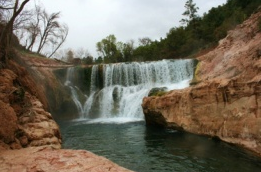Fossil Creek
 by Matthew J. Nelson
by Matthew J. Nelson
For millennia, Fossil Creek flowed from the limestone cliffs of the Mogollon Rim into the Verde River, creating the most diverse riparian area in Arizona. Along its 14-mile course, you’ll find 30 types of trees and shrubs, over a hundred bird species, and most of our state’s native fishes. Prolific springs gush 20,000 gallons per minute into the creek, making Fossil Creek a natural gem unlike any other in this part of the world.
But one hundred years ago that all changed.
In order to support mining activities in Jerome and to supply power to Phoenix’s burgeoning population, a hydroelectric facility was built. The majority of Fossil Creek’s flow was diverted into a flume, and the river practically ran dry. It was an ecological massacre that many thought would be irreversible. But history changed on June 18, 2005, when the power plant was decommissioned and Fossil Creek was set free. Now, only six years later, it is once again a ribbon of life in an arid land.
The miles pass quickly as you lose 1,800 feet of elevation in 3.6 miles. After an hour or so you’ll arrive at the canyon bottom. When you find the sign for the Mail Trail (to the northeast), turn left and head west toward the creek. Within a few minutes you’ll be at the water’s edge, and standing in awe at the sight of Fossil Creek.
Cool water cascades over sandstone shelves where deep pools await weary hikers. There are abundant places to sun on the warm rocks like a lizard, and cool cataracts where you can sit for hours and watch the clouds race across the clear blue sky. Believe it or not, it gets better the farther you walk downstream.
Less than one-half-mile later you’ll encounter Fossil Creek Falls, a gorgeous addition to this already magical hike. One hundred meters downstream from the falls are some of the most incredible swimming holes in this part of the state.
Beautiful surprises await adventurous hikers around every corner, and each pool will seem even more refreshing than the last. Wander downstream for as long as you’d like, but remember it’s a long hike back out. Fossil Creek is one of the Mogollon Rim Country’s natural wonders, and one day spent here may inspire you to fight for its preservation.
Making Your Escape
From Tucson, the most scenic route is north on Oracle Road (Hwy 77) to Globe. Just outside of Globe, head north on Hwy. 88 toward Roosevelt Lake. Continue north on Hwy. 188 and 87 toward Payson. Just north of Payson, go through the town of Pine (your last chance for gas and groceries) then go west on Fossil Creek Road. Less than 10 miles west of the town of Strawberry you’ll turn right and head east for a short distance to locate the Fossil Creek Trailhead. There is also great access to the creek from Fossil Creek Road (Forest Road 708), just 10 miles west of the trailhead. Excellent swimming holes and secluded areas can be found near the Sally May, Purple Mountain and Mazatzal access areas. Check out the map of Fossil Creek through the Forest Service website:
www.fs.fed.us/r3/coconino/recreation/red_rock/fossil-spgs-wild.shtml
If you continue west on Fossil Creek Road, it will take you to the town of Camp Verde (turn left at the stop sign), just off I-17, and you can head back to Tucson via I-17 and I-10.
A River Reborn
Before you go, check out the award-winning documentary film about the restoration of Fossil Creek, A River Reborn. Information about the film is available online: www.mpcer.nau.edu/riverreborn/
Category: RECREATION




